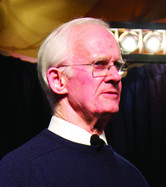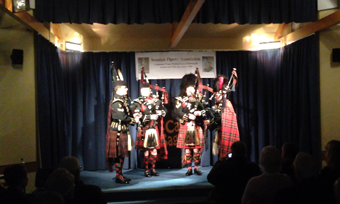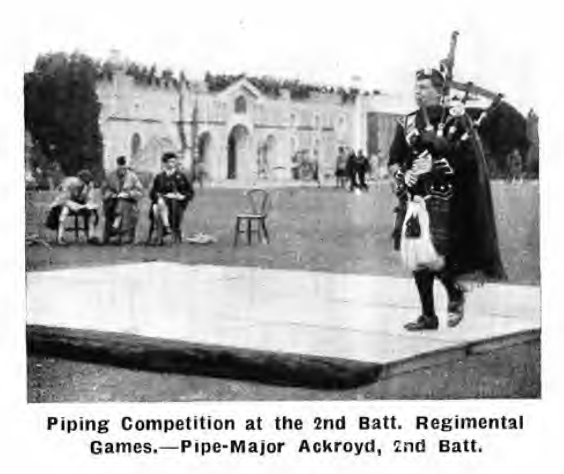 We now continue our detailed look at pipe tunes from the First World War performed at the Scottish Pipers’ Association concert on December 6th. Firstly, author Colin Campbell gives us some background to the first regiment featured, the Black Watch. For a review and information on tunes from earlier concerts click here.
We now continue our detailed look at pipe tunes from the First World War performed at the Scottish Pipers’ Association concert on December 6th. Firstly, author Colin Campbell gives us some background to the first regiment featured, the Black Watch. For a review and information on tunes from earlier concerts click here.
Six independent companies of troops loyal to the British government were formed in the 1720s and clad in dark government tartan. In 1739 they came together at Aberfeldy to form the regiment known as the Black Watch. They numbered 34 officers plus seven men from the Campbells, four Munros, four Stewarts, three Grants and one Fraser. The regiment was all but wiped out at Ticonderoga in America fighting the French in the Seven Years War. They went on to fight with distinction in the French Revolutionary and Napoleonic Wars, Crimea etc. In Balhousie Castle (left), the Black Watch Museum in Perth, there is a picture of a sergeant in WW1 marching order, waving his fists above his head:
‘Am sergeant Willum Henderson
Frae Perth that’s wha I am
An’ there’s jist ae bluidy regiment
On Airth that’s worth a dam.’
The regiment fought with distinction throughout WW1, both in the Middle East and on the Western Front. This poem by Private A. MacFarlane, 1/7th Black Watch, appeared in the Dunfermline Press:
‘Who is it mans the trench?
And sticks it, wet or fine;
Covered with blood or caked in mud?
Seventh Black Watch every time!
Grousing and swearing, but sticking,
‘Game’ to the call of ‘Time’,
Still ‘neath the light of the Very flare,
Black Watch, every time!
Tunes played by Army School pipers Cpl James Muir, The Black Watch, Cpl Peter Grant, The Highlanders, Cpl Jason Bruce, Royal Scots Dragoon Guards and Cpl Charles MacLean Royal Highland Fusiliers:
Blue Bonnets over the Border. Played by mixed companies. An old tune to which Sir Walter Scott added words in 1820.
The Atholl Highlanders. A Company. The name Atholl Highlanders dates from the formation of the 77th Regiment of Foot by the Duke of Atholl in 1777 but the name is now used for the Duke of Atholl’s pri
vate regiment.
Lord Alexander Kennedy. B Company. He was a younger son of the Marquis of Ailsa who served with the 42nd in the 1870s. He was a keen amateur piper. Tune by J Honeyman.
The Brown Haired Maiden. C company. A well-known Scots song to which soldiers sang the words ‘
‘Ah cannae see the target!
Ah cannae see the target!
Ah cannae see the target!
It’s ower faur awa’.
Scotland the Brave. The original name was Scotland for Ever and the title was based on an incident towards the end of the battle of Waterloo. The Dutch/Belgian division had broken and fled and the situation was critical. The cavalry brigade were in reserve and in front of them the line was held by the Black Watch, the Gordon Highlanders and the King’s Own Scottish Borderers, on whom the heaviest onslaught of the French fell, and the line was likely to break and give way, when the cavalry were ordered to advance. In front of the Scots Greys were the Gordon Highlanders. As the Greys charged through their ranks the Gordons rose up and caught hold of the stirrups and with cries of ‘Ninety-Second!’ and ‘Scotland for Ever!’ were carried along in the charge. Words were added by Cliff Hanley in the 1950s.
The Road to the Isles. Headquarters Company. Composed in 1891 by 16-year-old John MacLellan of Dunoon and called The Bens of Jura. In 1894 when John MacLellan sailed with HLI to Malta the tune suffered the first of many name changes when, at the request of his fellow pipers, it was re-named The 71st’s Farewell to Dover. About 1902 it became temporarily The Highland Brigade’s March to Heilbron and then later The Burning Sands of Egypt. It is probably best known as The Road to the Isles, when words were added and it became a popular song, but the composer never referred to it other than as The Bens of Jura, the name under which it was first published. Highland Laddie. A tune dating back to the early 18th century with many different sets of words.
The Black Bear. Battalion Regimental march. Spelled Black BERE in many old documents. Bere is the Scots word for barley. One variety has black beads on the heads and is known as black bere. Barley is used for making beer, the name of which comes from bere.

Tunes played by Donald McPhee:
3rd Battalion Dundee Home Guard. 6/8 After they had been established Home Guard units were permitted to wear the hat badge of their local regiment. In Dundee that could only have been the Black Watch, and any veterans in it would have been ex-Black Watch, not Dad’s Army [reference to a popular UK comedy show of the 70s and 80s].
P/M Dan Macleod. Transferred from 7 Royal Scots to 4 Black Watch when he moved from Edinburgh to work for D C Thomson in Dundee. Piped battalion onto action at Loos and won Military Medal for rescuing wounded men after the attack on 25 Sept 1915. Won a bar in 1917 for similar acts of gallantry. Joined Home Guard in WW2 and formed pipe band. Dan Macleod’s family were present to hear the tune played, and we were privileged to have them there.
[polldaddy poll=8482431]Sergeant Stuart MacMurchie DCM, MM. 2/4 march. Sgt. MacMurchie joined Royal Army Medical Corps thence to 1st Black Watch. He is commemorated in Dundee Congregational Church, Constitution Rd., and in the Roll of Honour in Sydney Morning Herald 6 August 1917. He was the son of Archibald MacMurchie, an Australian bridge builder. He left Aldershot with 1st Black Watch in 1914. That same year he won the Distinguished Conduct Medal for carrying messages under fire while wounded. He returned to the front in 1915 and was mentioned in dispatches at Loos, then received the Military Medal that October for rescuing a wounded officer. He was again wounded himself. Later when promoted sergeant in the 8th BW, 9th Div. he received a bar to the MM for rallying leaderless Seaforths. He was killed by a bomb in the suburbs of Arras on 3rd May 1917 and is buried in St Nicolas British Cemetery, Arras. He was aged only 22. If ever a soldier deserved a pipe tune it is Sergeant Stewart MacMurchie. His relatives in Australia watched the SPA concert via the live streaming on the internet.
Lt.Allan’s Wedding March. An ex-Seaforth officer gazetted to 2nd BW, then Adjutant 1 BW at the time of his wedding in 1909. Whether the P/M composed the tune because he wanted to, or because he was asked, we’ll never know.
P/M Thomas Clark. Joined in 1891, served in S Africa, led the Black Watch pipe band on a tour of Canada in 1903. Served until invalided home in 1916.
The Black Watch Welcome to Nigg. There were two training camps for the regiment at Nigg, north of Inverness.
Rev. Norman MacKay, Ross-shire. He was a Church of Scotland minister from Newtonmore to Nigg 1901-1948, the year of his death.
[easyrotator]erc_14_1414056032[/easyrotator]The Red Hackle. 2/4 The most distinctive and best known infantry hackle. Its origins are clouded in antiquity and there are several versions as to how it came to the BW. It was not universally worn at the start of WW1 – the headgear was a Glengarry with the regimental badge. Initially only worn by officers, then by all ranks. It may date from 1795 when the regiment retook guns from the French. Back in England, on King George III’s birthday a red feather was presented to each soldier. The hackle was confirmed in 1822 as the exclusive right of 42nd.
Andrew Kirk BW 1899 -1918 joined about 1899, served in South Africa and in Great War. Then Pipe Major and instructor for St Andrews BB.
The Red Hackle, Strathspey, is by Rev. Norman MacKay and the Black Watch Reel by P M Thomas Clark 1sst BW.
John MacColl’s Farewell to the Scottish Horse. The Scottish Horse battalions were formed in South Africa during the Boer War by the Marquis of Tullibardine (Royal Horse Guards). They were mounted infantry to counter the Boer commandos on horses. Disbanded at the end of the Boer War, they reformed in 1902. Both 1st and 2nd sailed on Transylvania to Malta where they re-equipped as infantry and landed at Suvla Bay in Gallipoli. Afterwards it was Egypt, Greece and then the Western Front where they became a battalion of the BW. John MacColl ( b. 1860) was manager of R G Lawrie, Glasgow, and was employed by the army to teach piping. He was born at Kentallen and worked at Bonawe Quarry. John MacColl was in the Scottish Horse for a time before he went to Glasgow in 1908 to RG Lawrie’s.
 P/M George Ackroyd. Enlisted as boy piper in 1916 and served for 23 years and eventually P/M of the 2nd BW. He emigrated to South Africa where he stablished the Transvaal Scottish Pipe Band. He was captured at Tobruk during WW2.
P/M George Ackroyd. Enlisted as boy piper in 1916 and served for 23 years and eventually P/M of the 2nd BW. He emigrated to South Africa where he stablished the Transvaal Scottish Pipe Band. He was captured at Tobruk during WW2.
P/M John Wilson A&SH. John Wilson had most of his left thumb and most of the first two fingers of his left hand blow off by a grenade which he found on 10th November 1918, when he was 12. Persistent man!
Captain GCS MacLeod. 2/4 march. Ex-Hampshire Regt to 1st Black Watch. Wounded in November 1914 and taken prisoner on 13 May 1915.
P/M Angus R Macleod. Tune written in 1909. P/M MacLeod was wounded at Neuve Chapelle. He was P/M 2nd Black Watch from 1919 to 1925, then served with the Liverpool Scottish until discharge in 1938. He was one of the three 2nd Black Watch pipers to survive the Great War.
The Clan MacRae Society. 2/4. Composed in 1920s at request of Lt Col John MacRae-Gilstrap, who commanded 11th BW in WW1. MacRae-Gilstrap was instrumental in having the iconic Scottish castle of Eilean Donan in Loch Duich, restored. Served in Black Watch in Sudan. The composer, P/M William Ferguson learned to pipe with 102nd BB in Glasgow. Served in Gallipoli, Egypt, Palestine and France. Became P/M 1/7th HLI. After the war he was P/M to City of Glasgow PB, which changed its name to Clan MacRae in 1924.
Black Watch Polka by P/M Albert E Crowe. Born and died in Arbroath. BW boy piper 1884 in the 2nd Black Watch. Served in Egypt and the Boer War. PM 5th BW, 15th Scottish.
More on this fascinating series to follow.
















Angus was born on Skye as far as I am aware. He died Liverpool I think sometime in late 1980’s. My father served in the Liverpool Scottish and as it happened Angus was a neighbour. I can tell you quite a great deal about Angus and his forming a Pipe Band in Liverpool during WWII. The band continued afterwards as Clan Macleod Pipe Band Liverpool with the sanction of Dame Flora Macleod. I became a member of the band after learning the pipes with some tuition from Angus. Hope this is of interest. Sadly do not know his middle name. More information and photos if interested.
Yes please do forward whatever you have Ken. RW
I am looking for information about Pipe Major Angus R. MacLeod who was Pipe Major in the Black Watch (1919-1925) and the Liverpool Scottish (1925-1939).
What was his middle name and his year/place of birth and death?
Who can help me?